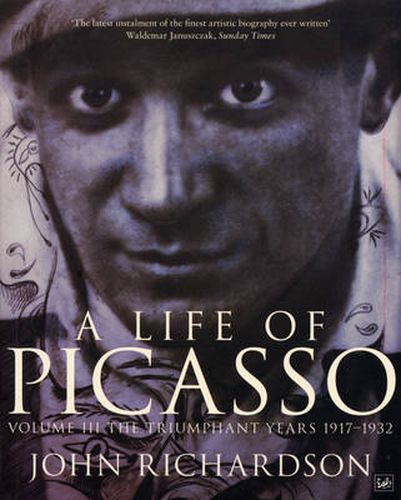Readings Newsletter
Become a Readings Member to make your shopping experience even easier.
Sign in or sign up for free!
You’re not far away from qualifying for FREE standard shipping within Australia
You’ve qualified for FREE standard shipping within Australia
The cart is loading…






The Triumphant Years takes up the artist’ s life in\n1917, when Picasso and Cocteau left wartime Paris for Rome to work\nwith Diaghilev’ s Ballets Russes on their revolutionary production\nof \“Parade,\” Visits to Naples, above all to the Farnese marbles in\nthe Museo Nazionale, would leave Picasso with a lifelong obsession\nwith classical sculpture as well as the self-referential commedia\ndell’ arte. After returning to Paris and marrying one of Diaghilev’\ns ballerinas, Olga Khokhlova, he abandoned bohemia for the drawing\nrooms of Paris. Hence, his so-called Duchess period, which\ncoincided with his switch to neoclassicism, and would ultimately be\nabsorbed into a metamorphic form of cubism.
\n
In the summer of 1923, Picasso and his American friends Gerald\nand Sara Murphy transformed the French Riviera from a winter into a\nsummer resort, when they persuaded the proprietor of the Hô tel du\nCap at Antibes to keep the place open for the summer. In doing so,\nthey made the Riviera Europe’ s major playground. Mediterraneanism\nwas in Picasso’ s bones. Born in Má laga, he would always identify\nwith this inland sea.
\n
In 1927 the artist’ s life underwent a major change; he\nabandoned society for a life out of the spotlight with a beautiful\nseventeen-year-old girl, Marie-Thé rè se Walter. His erotic\nobsession with Marie-Thé rè se would result in anever-growing\nantipathy for his neurasthenic, understandably jealous wife.\nBalletic clues have enabled Richardson to identify a number of\nbaffling figure-paintings as portrayals of Olga and reinterpret the\nwork of the late 1920s and early 1930s. Picasso’ s passionate love\nfor his mistress and his passionate hatred for his wife can be\nfully understood only in light of each other.
\n
The last three chapters constitute an annus mirabilis - spring\n1931 to spring 1932— during which the artist celebrated his\nfiftieth birthday. Challenged to scale new heights by the passage\nof time, Picasso lived up to his shamanic belief that painting\nshould have a magic function. In the course of this year, he\nreinvented sculpture and to a great extent his own imagery in a bid\nto Picassify the classical tradition. The resultant retrospective\nin Paris and Zurich in the summer of 1932 confirmed Picasso as the\nleader of the modern movement.
\n\n
$9.00 standard shipping within Australia
FREE standard shipping within Australia for orders over $100.00
Express & International shipping calculated at checkout
The Triumphant Years takes up the artist’ s life in\n1917, when Picasso and Cocteau left wartime Paris for Rome to work\nwith Diaghilev’ s Ballets Russes on their revolutionary production\nof \“Parade,\” Visits to Naples, above all to the Farnese marbles in\nthe Museo Nazionale, would leave Picasso with a lifelong obsession\nwith classical sculpture as well as the self-referential commedia\ndell’ arte. After returning to Paris and marrying one of Diaghilev’\ns ballerinas, Olga Khokhlova, he abandoned bohemia for the drawing\nrooms of Paris. Hence, his so-called Duchess period, which\ncoincided with his switch to neoclassicism, and would ultimately be\nabsorbed into a metamorphic form of cubism.
\n
In the summer of 1923, Picasso and his American friends Gerald\nand Sara Murphy transformed the French Riviera from a winter into a\nsummer resort, when they persuaded the proprietor of the Hô tel du\nCap at Antibes to keep the place open for the summer. In doing so,\nthey made the Riviera Europe’ s major playground. Mediterraneanism\nwas in Picasso’ s bones. Born in Má laga, he would always identify\nwith this inland sea.
\n
In 1927 the artist’ s life underwent a major change; he\nabandoned society for a life out of the spotlight with a beautiful\nseventeen-year-old girl, Marie-Thé rè se Walter. His erotic\nobsession with Marie-Thé rè se would result in anever-growing\nantipathy for his neurasthenic, understandably jealous wife.\nBalletic clues have enabled Richardson to identify a number of\nbaffling figure-paintings as portrayals of Olga and reinterpret the\nwork of the late 1920s and early 1930s. Picasso’ s passionate love\nfor his mistress and his passionate hatred for his wife can be\nfully understood only in light of each other.
\n
The last three chapters constitute an annus mirabilis - spring\n1931 to spring 1932— during which the artist celebrated his\nfiftieth birthday. Challenged to scale new heights by the passage\nof time, Picasso lived up to his shamanic belief that painting\nshould have a magic function. In the course of this year, he\nreinvented sculpture and to a great extent his own imagery in a bid\nto Picassify the classical tradition. The resultant retrospective\nin Paris and Zurich in the summer of 1932 confirmed Picasso as the\nleader of the modern movement.
\n\n